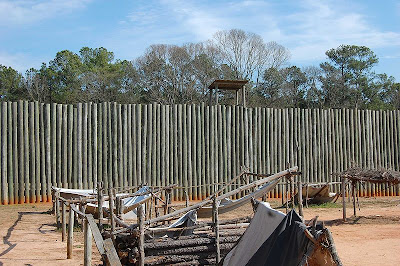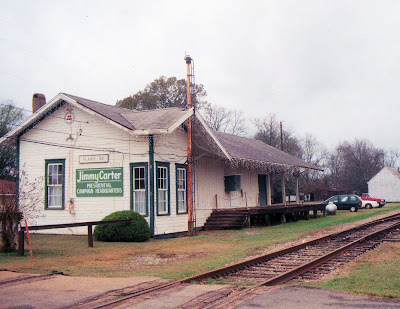 No amount of historical markers can truly paint the picture of the horror that took place at Camp Sumter near Andersonville, Georgia. The Andersonville National Historic Site that I was visiting this day as part of a national tour around the country following the events of September 11, 2001 preserves an oxymoronic institution, a concentration camp in the United States of America. This is one of the largest and oldest in the country, operating from February of 1864 through to the end of the war in April of the following year. Both sides in the War Between The States were guilty of inhumane conditions as the war dragged on, certainly by the latter stages of the contest. Particularly in the south food and weapons for the front lines were hard to come by leaving even less for the care of POWs at places like Andersonville.
No amount of historical markers can truly paint the picture of the horror that took place at Camp Sumter near Andersonville, Georgia. The Andersonville National Historic Site that I was visiting this day as part of a national tour around the country following the events of September 11, 2001 preserves an oxymoronic institution, a concentration camp in the United States of America. This is one of the largest and oldest in the country, operating from February of 1864 through to the end of the war in April of the following year. Both sides in the War Between The States were guilty of inhumane conditions as the war dragged on, certainly by the latter stages of the contest. Particularly in the south food and weapons for the front lines were hard to come by leaving even less for the care of POWs at places like Andersonville. In a war no one expected to last all that long prison camps seemed initially to be an afterthought. Both sides figured they would fight a few skirmishes then life would get back to  what each considered normal with everyone home in time for dinner. Didn't happen that way. And POW camps no one had a master plan for sprang up and, despite the best of intentions, broke down rapidly and appallingly. Early exchanges of prisoners fell apart over levels of authority and particularly over the status of Black soldiers, former slaves, that were captured in the south. It is not hard to imagine what the Confederacy wanted which in no way matched the Union desire to treat White and Black with no distinction. "Negros belonging to our citizens are not considered subjects of exchange," was General Lee's reply.
what each considered normal with everyone home in time for dinner. Didn't happen that way. And POW camps no one had a master plan for sprang up and, despite the best of intentions, broke down rapidly and appallingly. Early exchanges of prisoners fell apart over levels of authority and particularly over the status of Black soldiers, former slaves, that were captured in the south. It is not hard to imagine what the Confederacy wanted which in no way matched the Union desire to treat White and Black with no distinction. "Negros belonging to our citizens are not considered subjects of exchange," was General Lee's reply.
 what each considered normal with everyone home in time for dinner. Didn't happen that way. And POW camps no one had a master plan for sprang up and, despite the best of intentions, broke down rapidly and appallingly. Early exchanges of prisoners fell apart over levels of authority and particularly over the status of Black soldiers, former slaves, that were captured in the south. It is not hard to imagine what the Confederacy wanted which in no way matched the Union desire to treat White and Black with no distinction. "Negros belonging to our citizens are not considered subjects of exchange," was General Lee's reply.
what each considered normal with everyone home in time for dinner. Didn't happen that way. And POW camps no one had a master plan for sprang up and, despite the best of intentions, broke down rapidly and appallingly. Early exchanges of prisoners fell apart over levels of authority and particularly over the status of Black soldiers, former slaves, that were captured in the south. It is not hard to imagine what the Confederacy wanted which in no way matched the Union desire to treat White and Black with no distinction. "Negros belonging to our citizens are not considered subjects of exchange," was General Lee's reply. As bad as the outside forces were there was a unique troop at the camp known as the Andersonville Raiders. These were fellow inmates who bullied and killed other  prisoners for the sake of food, tradable goods and other comforts before they were caught by an opposing group called "the Regulators" who sought justice such as it was available. Six of the Raiders were hanged for their crimes in a mock court of their peers while their captors looked on. Politics on both sides through intractable demands and poverty throughout the Confederacy combined to make conditions worse by the day and fueled a growing resentment up North towards the people of Dixie.
prisoners for the sake of food, tradable goods and other comforts before they were caught by an opposing group called "the Regulators" who sought justice such as it was available. Six of the Raiders were hanged for their crimes in a mock court of their peers while their captors looked on. Politics on both sides through intractable demands and poverty throughout the Confederacy combined to make conditions worse by the day and fueled a growing resentment up North towards the people of Dixie.
 prisoners for the sake of food, tradable goods and other comforts before they were caught by an opposing group called "the Regulators" who sought justice such as it was available. Six of the Raiders were hanged for their crimes in a mock court of their peers while their captors looked on. Politics on both sides through intractable demands and poverty throughout the Confederacy combined to make conditions worse by the day and fueled a growing resentment up North towards the people of Dixie.
prisoners for the sake of food, tradable goods and other comforts before they were caught by an opposing group called "the Regulators" who sought justice such as it was available. Six of the Raiders were hanged for their crimes in a mock court of their peers while their captors looked on. Politics on both sides through intractable demands and poverty throughout the Confederacy combined to make conditions worse by the day and fueled a growing resentment up North towards the people of Dixie. In a camp built for 10,000 there were three times that many enlisted men here after hardly eight months of  operations. The cemetery to the north of the camp holds the remains of its victims, nearly 13,000 people, over 900 of those unknown. The six Raiders are here, too, though buried some distance away from the honorable dead. Of particular note to me are the markers of "USCT" troops buried here. "USCT" stands for United States Colored Trooper, a man on one side, returned property on the other. How they must have been treated by the guards.
operations. The cemetery to the north of the camp holds the remains of its victims, nearly 13,000 people, over 900 of those unknown. The six Raiders are here, too, though buried some distance away from the honorable dead. Of particular note to me are the markers of "USCT" troops buried here. "USCT" stands for United States Colored Trooper, a man on one side, returned property on the other. How they must have been treated by the guards.
 operations. The cemetery to the north of the camp holds the remains of its victims, nearly 13,000 people, over 900 of those unknown. The six Raiders are here, too, though buried some distance away from the honorable dead. Of particular note to me are the markers of "USCT" troops buried here. "USCT" stands for United States Colored Trooper, a man on one side, returned property on the other. How they must have been treated by the guards.
operations. The cemetery to the north of the camp holds the remains of its victims, nearly 13,000 people, over 900 of those unknown. The six Raiders are here, too, though buried some distance away from the honorable dead. Of particular note to me are the markers of "USCT" troops buried here. "USCT" stands for United States Colored Trooper, a man on one side, returned property on the other. How they must have been treated by the guards. Andersonville is yet another part of the Civil War that most in this country simply prefer to avoid discussing. The battlefields draw millions as do the museums but few travel to a place the combatants themselves located well off the beaten path even then. The history of the Civil War prison camp includes over 150 such camps, some probably worse than Andersonville, some with familiar names like Belle Isle in Richmond or Rock Island, Illinois, even Ft. McHenry in Baltimore, where Francis Scott Key wrote the Star Spangled Banner! Ft. Delaware, a union camp outside of Wilmington and Elmira, New York are both said to have rivaled Andersonville in nearly every respect except scale. Elmira charged 15-cent admission just to watch the prisoners mill around.
I joined the line of cars on I-75 north to Atlanta. Some of my fellow motorists might have been interested in the events that occurred less than 20 miles off the highway. Others roared past in a hurry no doubt to no place really that important. If asked they surely would have said "Such things simply could not have happened here."
Gotta go.




























